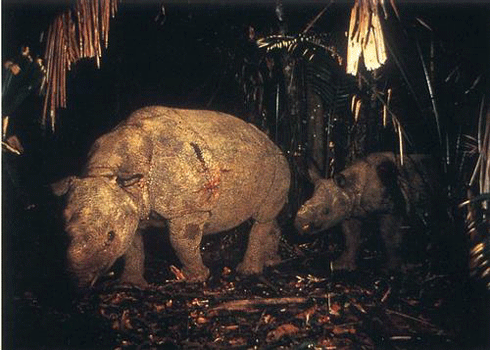
|
Published: 2 May 2012
Endangered Javan rhinos on film
The world’s only population of Javan rhino will now be more closely monitored, thanks to the quadrupling of video camera traps in their last remaining habitat in Indonesia.

|
|
A rare photo of a Javan rhinoceros mother and calf, taken by a photo camera trap in Ujung Kulon National Park, Java, Indonesia Credit: World Wildlife Fund Indonesia
|
The Javan rhinoceros, considered among the most endangered large animal species on the planet, now exists in only one area, the Ujung Kulon National Park of Indonesia on the south-west tip of Java. Experts believe there are fewer than 50 Javan rhinos remaining.
The rhinos in the Park, will now be monitored by 160 video cameras, 120 of which have been recently donated by the WWF and the IRF.
The need to have additional video cameras for rhino observation was first recognised during an International Union for the Conservation of Nature meeting in West Java in 2011. The head of Ujung Kulon National Park, Moh Haryono, reported that in 2011, the year when the park officially began using video camera traps, 35 individuals comprising 22 males and 13 females were identified.
‘The Javan rhino population in Ujung Kulon has been the last fortress of the Javan rhino population in the world ever since the extinction of Javan rhino in Vietnam in 2011,’ says IRF Director Susie Ellis.
‘By integrating video information gathered from camera trap with DNA based monitoring, we can get a better description of the Javan rhino population, and an even deeper understanding of rhino behaviors,’ says Adhi Hariyadi, coordinator of WWF-Indonesia’s Rhino Conservation Program.
‘With the total of 160 video camera traps placed simultanously around the park, we can collect various information, not only on javan rhino but also other wildlife,’ says Moh Haryono.
WWF has been working with Ujung Kulon National Park to observe the Javan rhino population using camera traps since the 1990s. At that time the park was the first park in Indonesia to identify wildlife using still photo camera traps. In 2008 video camera traps replaced the photo camera traps.
Source: World Wildlife Fund
More information
Videos of Javan rhinos taken by video camera traps in Ujung Kulon National Park, Java, Indonesia.



